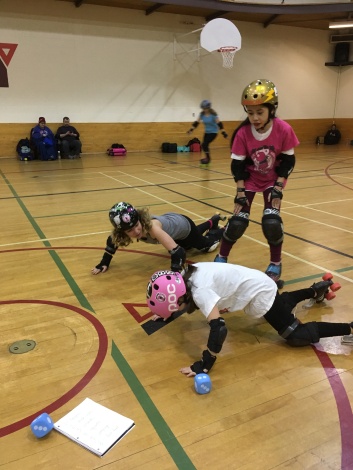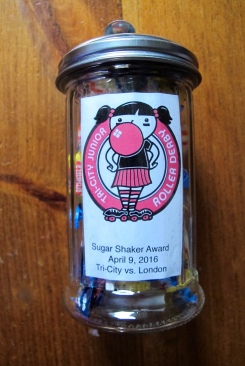
Far too often, many leagues have difficulty finding referees to officiate their games. Some leagues get around this problem by having skaters wear stripes or just dealing with a short crew. Some leagues in my area would stand on their head to get qualified refs and look for help months and months in advance.
This is especially true of junior roller derby.
Many times, junior games get staffed by “whomever is around.” You can fight me on this but I think junior roller derby should have the BEST referees in the area. Certainly, everyone needs a start but staffing a juniors game with all brand-new refs won’t likely end well.
Junior games need referees who are good at crowd control. Calling a young skater a “fat pig” SHOULD get you ejected from the building. Further, no referee should ever have to deal with verbal abuse poised to themselves either.
Junior games need referees who are good with youths. Yelling at a skater because she’s so new she forgot to exit the track to get to the penalty box is not cool. Apologizing or at least explaining in a calm manner when you saw you made her cry would also be a classy and mature move. Just saying.
Junior games need referees who know the rules of the sport well. They are there to keep the skaters safe and the sport fair. Many parents would say they get nervous when they see their child play for fear of injury. This makes a good head ref worth their weight in gold; a good ref crew as precious as rare gems.
What is your league doing to promote and honour officials (both skating and non-skating)? Are they getting sufficient practice time? Are you helping to recruit? Do you feed them – it sounds trite but I’ve seen officials brighten right up when they’ve travelled so far and are met with a plate of sandwiches and a crock pot of chili.
We’re fortunate to have many amazing officials nearby. They’ve come to our practices to help the skaters learn the rules a little better. We’ve had full crews both on and off skates to help officiate even the most informal intraleague scrimmages. They meet often and support each other.
One of our parent leagues has a bursary called the Jules and Regulations Award (http://tricityrd.com/jules-reg/) which honours a female-identifying official who has demonstrated excellence in officiating women’s flat track roller derby and in empowering other female-identifying officials. Jules herself has made countless contributions to officiating, mentoring, and increasing gender diversification within roller derby officiating.
One of those she has mentored? The boy in the photo above. Starting out at 9-years-old, he never wanted to play the game but, instead, something about officiating entranced him.
He was – and still is – lucky to have many show him the ropes. Starting with junior derby coaches who had developed his skating and taking the time to discuss the rules of the sport with him, it was other referees who got him game-worthy. He would shadow refs who would take the time between jams to explain what was going on. Refs would guide him to useful online resources and made themselves available for any of his questions with patience and respect. He’s also been trusted to officiate in non-sanctioned adult games, handled all referee positions including HR, and is confident enough to approach junior skaters to ask if they had any questions or concerns about his calls or the game in general (just as his mentors do). His next goal is to be a certified WFTDA referee as soon as he is eligible. When he turns 18 in 2021, he’ll have been in stripes for nine years.
The road wasn’t without hiccups. I’ve heard many stories of youth refs being discounted in one way or another, which does nothing to elevate not only junior derby but roller derby entirely. Put down a junior ref and that person might give up. Where’s the future now?
We need to make things easier for junior roller derby officials. It’s an issue in many children’s sports but there needs to be a greater culture of respect and appreciation for officials from players, parents and spectators. I’ve heard far too many refs say they will never work a juniors game because they don’t want to hear disparaging remarks from parents.
Other ways to be more encouraging? Our league doesn’t charge a registration fee for those youths who just want to ref. Other leagues actively recruit for youth officials, sometimes even within – looking to family and friends. We recently participated at the ECDX tournament in Philadelphia and every participating junior league had to have skaters or referees commit to a total of several officiating hours (per league, not per skater). It was a brilliant way to get skaters NSOing and refereeing, highlighting their capabilities and surely improved their knowledge of their sport.
We talk a lot about being inclusive in roller derby. Let’s not forget the junior (and adult) who wants to officiate.
Photo appears courtesy of junior derby dad, all-around great guy, and amazing photographer Jeff Ostrander (jeffostrander.smugmug.com).


 The easiest defensive move you can teach children, in my opinion, is the wall – blockers lined up across the track with the sides of their bodies touching. Since we teach the skaters to play positional blocking only to start, this is typically the introduction – and cornerstone – to effective blocking.
The easiest defensive move you can teach children, in my opinion, is the wall – blockers lined up across the track with the sides of their bodies touching. Since we teach the skaters to play positional blocking only to start, this is typically the introduction – and cornerstone – to effective blocking.
 Lately at practices, one of our skaters has been asking some seemingly odd questions.
Lately at practices, one of our skaters has been asking some seemingly odd questions.